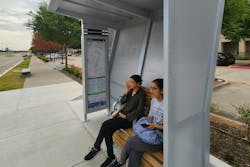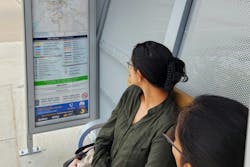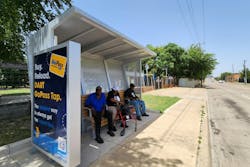Innovative Student Design Shapes Future of DART's Next Generation Bus Shelters
Vanessa Lopez put a lot of thought into what she wanted to incorporate into a bus shelter design that would work for Dallas Area Rapid Transit (DART) riders now and into the future. DART and its partners, KAI Enterprises, HDR and Tolar Manufacturing Company, made Lopez’s design into a working, functional bus shelter.
This may sound like an everyday process between a transit agency and its design and manufacturing partners but this story is different. Lopez was one of 16 college students that worked on concept designs for the project, working with DART to gather ideas and rider feedback to develop what would become the transit agency’s Next Generation Bus Shelter.
DART partnered with the University of Texas at Arlington’s (UTA) College of Architecture, Planning and Public Affairs and the American Institute of Architects (AIA) Dallas Chapter to sponsor a student-design collaboration for new bus shelters in fall 2022. Fast forward to the summer of 2024 and those concept designs have become reality, with DART installing three versions of the new bus shelter prototypes at five bus stop locations in its service area to kick off its new pilot program.
“We’re looking to see how these shelters and all their new features are received by our riders,” said Brandi Stringer, director of mobility capital projects for DART. “Our number one goal is to provide an amenity at our bus stops that riders love and adds to their experience when riding DART.”
Stringer and her team developed a survey to collect feedback from DART stakeholders, including riders, on the appearance, design, construction, technological enhancements and other features of the new shelters.
The 16 UTA students who participated in the concept design program provided insights by riding the system to determine perceived strengths and weaknesses, interviewing riders, visiting and analyzing spaces at key destinations and attending focus groups with key stakeholders. DART then partnered with Tolar Manufacturing Company and utilized the UTA student concepts to create a shelter based on feedback previously gathered from DART bus riders asking what they wanted and needed from a bus shelter.
Lopez and her fellow UTA classmates used those details and their own research to create a concept shelter that earned the Texas Student Honor Award from the American Society of Landscape Architects in 2023.
“The partnership with DART was an amazing experience for our students to test their design capabilities while learning to fit in the public’s everyday needs in a bus shelter,” said Julia Lindgren, assistant professor of architecture at UTA. “We were honored to have our students’ work recognized and now, seeing some of those ideas and concepts incorporated into the prototype bus shelters DART is using to gauge public feedback, it’s even more impressive. This is the type of real-world experience you want for your students as an instructor.”
DART will determine if all three of the new bus shelter prototypes will fit its needs as is, if changes need to be made to the current prototypes or if it can simplify and use a two-model system. Feedback gathered in 2023 determined that riders wanted more protection from the elements, improved lighting for safety and visibility and real-time bus arrival information as top priorities for the new design.
The new shelters incorporate those priorities within the two larger models – standard-width and slim-width shelters – and feature Alucobond in the roof panels, designed to have cooling properties beyond that of standard aluminum, and perforated back and side panels to allow for improved air flow. They also feature built-in composite high-density polyethylene benches, solar-powered LED lighting with improved light levels and remote monitoring, allowing for quicker repairs and enhanced customer safety, electronic displays that share real-time bus arrival information and allows for the agency to push out urgent messaging, including major system-wide delays or weather-related incidents that impact service, a backlit system map display and slim perforated panel that provides increased visibility for bus operators, which should reduce pass-bys.
“The Tolar Manufacturing team appreciates the opportunity to collaborate with DART staff and UTA students and faculty to turn the Next Generation Bus Shelters from concept to reality. The results reflect the commitment of Vanessa and her fellow classmates to improving the public transportation experience led by DART for a better public transportation experience for all riders that starts at the bus stop,” said Patrick Merrick, executive vice president at Tolar Manufacturing Company.
The mini shelter was designed for areas that don’t have the space for a larger bus shelter or don’t have a high-enough ridership to qualify for a larger shelter. These smaller units are open air with a raised base with seating for two, a large, slanted roof allowing standing riders coverage from the elements and solar powered LED illumination.
DART’s pilot program will run through November 2024, allowing the agency ample time to gather feedback from its stakeholders and riders while checking the responsiveness of the shelters to north Texas weather and everyday use. A final next generation bus shelter design is expected by the end of the year, which will be used throughout the DART network.
“This is the type of collaboration we want as we begin the process of modernizing and transforming our system,” said Dee Leggett, executive vice president and chief development officer for DART. “From concept design to prototype delivery, these new bus shelters show we considered the needs of our customer base and delivered while adding functional value to a space in each of the cities we serve.”
DART Next Generation pilot bus shelter locations include:
- Mini Shelter at Ross Avenue and Hall Street in Dallas
- Standard Shelter at Malcolm X Boulevard and Clarence Street in Dallas
- Standard Shelter at Hedgcoxe and Preston roads in Plano
- Slim Shelter at Synergy Park Boulevard and Rutford Road in Richardson
- Slim Shelter at Northwest Highway and Marketplace Drive in Garland
With ample coverage from the elements, seating for riders, increased lighting and a digital passenger information display that provides real-time bus arrival information, the Next Generation DART Bus Shelters look to enhance the customer experience while modernizing bus service across its service area.

Mario Zavala Jr. | project communications manager in the Development Department for Dallas Area Rapid Transit.
Mario Zavala serves as the project communications Manager for Dallas Area Rapid Transit (DART). He oversees communication efforts for all current and future DART projects under development, including the Silver Line Regional Rail project. Zavala brings more than a decade of experience in public engagement, marketing and communications, having served in leadership roles with the Denton Independent School District and CoServ, the third-largest electric co-operative in the country.
He is a former journalist, having worked with the Dallas Morning News, Fort Worth Star-Telegram and Fox Sports, among many media outlets. Prior to joining DART, Zavala worked in corporate public relations, handling several high-profile restaurant and hospitality clients. A graduate of the University of Texas at Austin, he holds a bachelor’s degree in journalism and is a longtime DFW resident.








